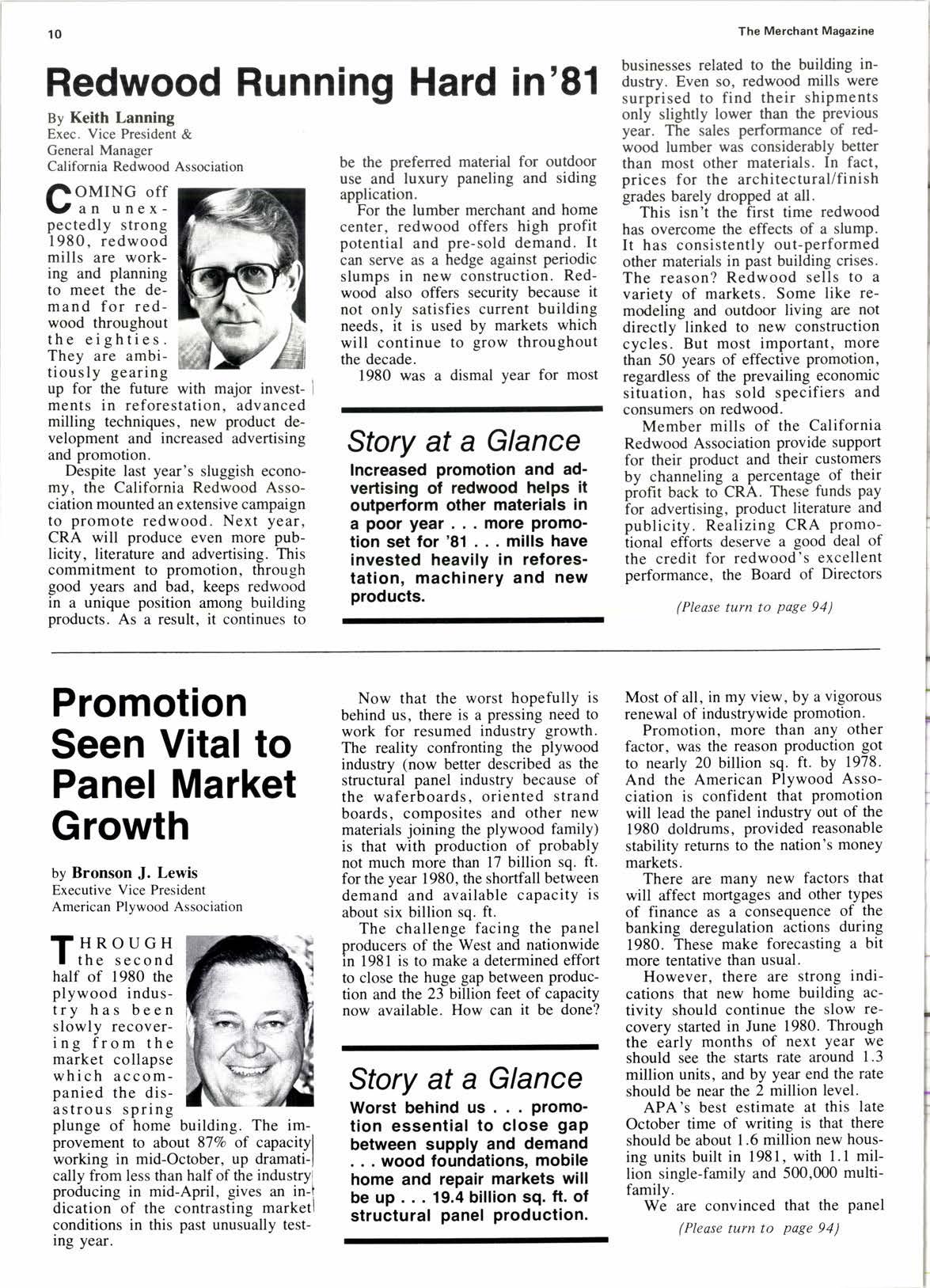
2 minute read
Promotion Seen Vital to Panel Market Growth
by Bronson J. Lewis Executive Vice President American Plywood Association
HROUGH the second half of 1980 the plywood industry has been slowlv recovering from the market collapse which accompanied the disastrous spring plunge of home building. The improvement to about 87Vo of capacityl working in mid-October, up dramati-l cally from less than half of the industryl producing in mid-April, gives an in-! dication of the contrasting marketl conditions in this past unusually testmg year.
be the preferred material for outdoor use and luxury paneling and siding application.
For the lumber merchant and home center, redwood offers high profit potential and pre-sold demand. It can serve as a hedge against periodic slumps in new construction. Redwood also offers security because it not only satisfies current building needs, it is used by markets which will continue to grow throughout the decade.
1980 was a dismal vear for most
Story at a Glance
Increased promotion and advertising of redwood helps it outperform other materlals in a poor year more promotion set for '81 mills have invested heavily in reforestation, machinery and new products.
Now that the worst hopefully is behind us, there is a pressing need to work for resumed industry growth. The reality confronting the plywood indusfry (now better described as the structural panel industry because of the waferboards, oriented strand boards, composites and other new materials joining the plywood family) is that with production of probably not much more than 17 billion sq. ft. forthe year 1980, the shortfall between demand and available capacity is about six billion sq. ft.
The challenge facing the panel producers of the West and nationwide in l98l is to make a determined effort to close the huge gap between production and the 23 billion feet of capacity now available. How can it be done?
Story at a Glance
Worst behind us . promotion essential to close gaP between supply and demand wood foundations, mobile home and repair markets will be up 19.4 billion sq. ft. of structural panel production.
The Merchant Magazine businesses related to the building industry. Even so, redwood mills were surprised to find their shipments only slightly lower than the previous year. The sales performance of redwood lumber was considerably better than most other materials. In fact, prices for the architectural/finish grades barely dropped at all.
This isn't the first time redwood has overcome the effects of a slump. It has consistently out-performed other materials in past building crises. The reason? Redwood sells to a variety of markets. Some like remodeling and outdoor living are not directly linked to new construction cycles. But most important, more than 50 years of effective promotion, regardless of the prevailing economic situation, has sold specifiers and consumers on redwood.
Member mills of the California Redwood Association provide support for their product and their customers by channeling a percentage of their piofit back to-CRA. ThesJ funds pay for advertising, product literature and publicity. Realizing CRA promotional efforts deserve a good deal of the credit for redwood's excellent performance, the Board of Directors
(Please turn to page 94)
Most of all, in my view, by a vigorous renewal of industrywide promotion. Promotion, more than any other factor, was the reason production got to nearly 20 billion sq. ft. by 1978. And the American Plywood Association is confident that promotion will lead the panel industry out of the 1980 doldrums, provided reasonable stability returns to the nation's money markets.
There are many new factors that will affect mortgages and other types of finance as a consequence of the banking deregulation actions during 1980. These make forecasting a bit more tentative than usual.
However, there are strong indications that new home building activitv should continue the slow recoueiy started in June 1980. Through the early months of next Year we should see the starts rate around 1.3 million units, and by year end the rate should be near the 2 million level.
APA's best estimate at this late October time of writing is that there should be about 1.6 million new housing units built in 1981, with l.l million single-family and 500,000 multifamily.
We are convinced that the panel (Please turn to page 94)










